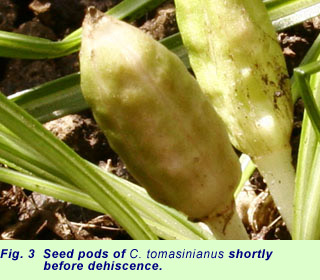Crocus tomasinianus
Click on any of the images to see full resolution.
 ‘Tommies’ must be one of the glories of the late winter. Flowering about the same time as the snowdrops, they are one of those signs that winter has almost run its course. They need a warmish sunny day to give their best show, but they’re patient; if the weather is cold and grey the buds will stand for two or three weeks waiting for the moment. ‘Tommies’ must be one of the glories of the late winter. Flowering about the same time as the snowdrops, they are one of those signs that winter has almost run its course. They need a warmish sunny day to give their best show, but they’re patient; if the weather is cold and grey the buds will stand for two or three weeks waiting for the moment.
They naturalise well in a lawn (Fig. 1 - left) and propagate both from the corm and by seed. The only drawback is that in order to let the corms regenerate, you can’t mow the lawn until well into the late spring, so it does begin to get a bit raggy, though it recovers in the summer. In any case, it’s well worth it for the late winter show.
 Fully open, the flower is 1½” /36mm across, the petals a pale lilac, the anthers and stigma a bright orange/yellow. Rather than growing as scattered individuals, they tend to grow in clumps where individual corms have propagated themselves by offsets (Fig. 2 - right); although as the density of plants increases with time, this becomes gradually less obvious. Fully open, the flower is 1½” /36mm across, the petals a pale lilac, the anthers and stigma a bright orange/yellow. Rather than growing as scattered individuals, they tend to grow in clumps where individual corms have propagated themselves by offsets (Fig. 2 - right); although as the density of plants increases with time, this becomes gradually less obvious.
 The seed pods are tricky to find in grass, but easier where C. tomasinianus has spread into borders. If you clear some of the dying foliage about mid-May you’ll find them (Fig. 3 - left) - yellow-green cylinders, tapered at the top, about ¾”/18mm long, with the outline of seeds clearly visible through the thin wall. Also visible are the abscission lines along which the pod will dehisce. The seed pods are tricky to find in grass, but easier where C. tomasinianus has spread into borders. If you clear some of the dying foliage about mid-May you’ll find them (Fig. 3 - left) - yellow-green cylinders, tapered at the top, about ¾”/18mm long, with the outline of seeds clearly visible through the thin wall. Also visible are the abscission lines along which the pod will dehisce.
The mature corm is about ½”/12mm across. Once dormant it’s very robust; it doesn’t seem to mind being dug up and left lying around, provided it’s covered up by mid-autumn.
Because the foliage has largely died back by the time the trees come into full leaf, C. tomasinianus will establish under deciduous trees.
Click here to see micrographs of open anther.
|